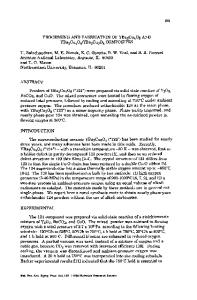Signal-off photoelectrochemical determination of miRNA-21 using aptamer-modified In 2 O 3 @Cu 2 MoS 4 nanocomposite
- PDF / 1,372,751 Bytes
- 9 Pages / 595.276 x 790.866 pts Page_size
- 15 Downloads / 284 Views
ORIGINAL PAPER
Signal-off photoelectrochemical determination of miRNA-21 using aptamer-modified In2O3@Cu2MoS4 nanocomposite Ling Dan Yu 1 & Yu Xia Wen 1 & Xing Yue Zhang 1 & Nian Bing Li 1
&
Hong Qun Luo 1
Received: 31 May 2020 / Accepted: 30 August 2020 # Springer-Verlag GmbH Austria, part of Springer Nature 2020
Abstract In2O3@Cu2MoS4 nanocomposite with superior photoelectrochemical (PEC) performance is used for the first time as a photoactivity material, and a signal-off PEC biosensing platform for miRNA detection has been successfully constructed. Firstly, the Cu2MoS4 nanosheets are synthesized by a hydrothermal method, and then, the homogeneous In2O3 nanoparticles (In2O3 NPs) are synthesized by calcination in the air. The In2O3@Cu2MoS4 nanocomposite is constructed with the Cu2MoS4 nanosheets as matrix and In2O3 NPs as sensitizer through a layer-by-layer assembly strategy. The nanocomposite with a tight interface and the matched band structure restrains the electron-hole pair recombination. Under visible light (400–700 nm), the nanocomposite exhibits a strong initial signal. With the catalyzed hairpin assembly, dozens of PbS quantum dots (QDs) are introduced on the surface of an electrode, significantly reducing the photocurrent of n-type In2O3@Cu2MoS4. Since PbS QDs can compete with the nanocomposite for light energy and electron donors, the signal decreased. Under optimal conditions, the biosensor manifests a broad linear range (1 fM–1 nM) and a low detection limit of about 0.57 fM, at a working potential of 0 V (vs. Ag/AgCl). The recovery of spiked human serum is between 94.0 and 102%, and the relative standard deviation (RSD) is between 1.3 and 2.7%. Therefore, the as-fabricated biosensor exhibits a potential for the determination of miRNA-21 in practical applications. Keywords Photoelectrochemical biosensor . In2O3@Cu2MoS4 nanocomposite . PbS QDs . Aptasensor
Introduction In recent years, miRNAs have gained increasing attention of researchers, as miRNAs play an important regulatory role in a series of gene expressions [1, 2]. The expression of miRNAs is closely related to the diagnosis, treatment, and physiological processes in the organism [3]. In addition, according to the report, various momentous diseases were interrelated with the aberrant expressions of miRNAs, such Electronic supplementary material The online version of this article (https://doi.org/10.1007/s00604-020-04540-z) contains supplementary material, which is available to authorized users. * Nian Bing Li [email protected] * Hong Qun Luo [email protected] 1
School of Chemistry and Chemical Engineering, Southwest University, 2, Tiansheng Road, BeiBei District, Chongqing 400715, People’s Republic of China
as cancers, malignancies, and heart disease [4, 5]. Various techniques have been exploited to detect miRNAs, for instance, colorimetry [6], fluorescence [7, 8], electrochemiluminescence (ECL) [9], electrochemistry [10, 11], and capillary electrophoresis [12]. However, due to the instability of microRNA, low content and short length, and
Data Loading...











